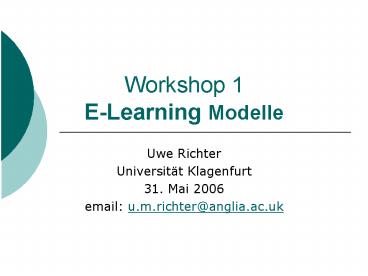Workshop 1 ELearning Modelle - PowerPoint PPT Presentation
1 / 10
Title:
Workshop 1 ELearning Modelle
Description:
Koordinator der E-Learning Unit, University Centre for Learning and Teaching, ... f r Lehr-veranstaltungen, Lehr/Lern-material und Ressourcen online, verschiedene ... – PowerPoint PPT presentation
Number of Views:50
Avg rating:3.0/5.0
Title: Workshop 1 ELearning Modelle
1
Workshop 1 E-Learning Modelle
- Uwe Richter
- Universität Klagenfurt
- 31. Mai 2006
- email u.m.richter_at_anglia.ac.uk
2
Zu meiner Person
- Uwe Matthias Richter
- Leiter der Deutschabteilung, ALSS
- Koordinator der E-Learning Unit, University
Centre for Learning and Teaching, - Anglia Ruskin University, Cambridge ,
Großbritannien - Email u.m.richter_at_anglia.ac.uk
3
E-learning in GroßbritannienHEFCE e-learning
strategy (March 05)
- Commitment to fully embed e-learning in a
sustainable way within the next 10 years - meet the greater diversity of student needs
- increase flexibility of provision
- enhance the capacity for integrating study with
work and leisure through work-based and
home-based learning - develop approaches to individualised support for
planning and recording achievements - 10 Measures of success
- http//www.hefce.ac.uk/learning/elearning/
- HEFCE Higher Education Funding Council England
4
DfES e-(learning) strategy (March 2005)
- The strategy sets out to achieve four
overarching - objectives
- transforming teaching, learning and child
development, enabling children and learners of
all ages to meet their highest expectations - connecting with hard to reach groups in new ways
- opening up education to partnerships with other
organisations - moving to a new level of efficiency and
effectiveness in our delivery. - http//www.dfes.gov.uk/publications/e-strategy/
- DfES Department for Education and Skills
5
Going online in Stufen
- Stufe 1 Web Präsenz
- Kerninformation für Lehrveranstaltungen z.B.
kommentiertes Vorlesungsverzeichnis - Stufe 2 Erweiterte Web Präsenz
- Präsenzunterricht mit Kerninformation für
Lehrveranstaltungen plus ausgewähltes
Lehr/Lernmaterial und Ressourcen online - Stufe 3 Web gestütztes Lernen 1
- Präsenzunterricht, aber mit Online-Ressourcen/Lern
materialien und Lernaktivitäten sind
verpflichtender Bestandteil. - Stufe 4 Web gestütztes Lernen 2
- Präsenzunterricht, ist integriert im Lernen
online. Online Lernaktivitäten fördern
unabhängiges Lernen und Forschen.
Präsenzunterricht unterstützt online Lernen.
Enthält Online-Kommunikation und/oder
Prüfungsformen. - Stufe 5 Web basiertes Fernstudium
- Lernmaterialien, Kommunikation und Prüfungsformen
vollkommen online.
BLENDED
6
Vom Präsenz- zum Fernlernen
- Präsenz Blended
Fernlernen - Optionale Lernerpartizipation
verpflichtende Lernerpartizipation
Web Präsenz Kerninformation für
Lehr-veranstaltungen
Erweiterte Web Präsenz Kerninformation für
Lehr-veranstaltungen plus ausgewähltes
Lehr/Lern-material und Ressourcen online
Fernstudium Kerninformation für
Lehr-veranstaltungen, Lehr/Lern-material und
Ressourcen online, verschiedene Formen der
Interaktivität Komplett online
Web gestütztes Lernen Kerninformation für
Lehr-veranstaltungen, Lehr/Lern-material und
Ressourcen online plus verschiedene Formen der
Interaktivität
7
Models of Online Learning
- Margot Bell, et al (2002) Universities Online. gt
Appendix C Online course Definitions - Mode A Web Supplemented (optional online
participation) - Enrolled students can access information on
units of study that is additional to that
available in the universitys calendar or
handbook. .. The information is used to
supplement traditional forms of delivery. - Mode B Web Dependent (compulsory, may include
some f2f components) - Students must use the web to interact with
education content necessary for study - Students must use the web to communicate with
staff and/or students - Students must use the web both to interact with
content and to communicate with staff and/or
students - Mode C - Fully Online
- All interactions with staff and students,
education content, learning activities,
assessment and support services are integrated
and delivered on line
- Robin Mason (1998) Models of Online Courses
- Content Support Model
- It relies on the separation between course
content .. and tutorial support ...The model
supports the notion of relatively unchanged
content materials ... However, these online
elements tend to be added onto the course ...
Considering the course as a whole, the online
component represents no more than 20 of the
students study time in this model. - Wrap Around Model
- .. Consists of tailor made materials ..
wrapped around existing materials ... I
categorize this as the 50/50 model because the
online interactions and discussions occupy about
half the students time, while the predetermined
content occupies the other half. - Integrated Model
- the course consists of collaborative activities,
learning resources and joint assignments. The
heart of the course takes place online through
discussion, accessing and processing information
and carrying out tasks.
8
Und Sie? Quo vadis
- In Gruppen diskutieren Sie
- folgende Aspekte
- Wie nutzen Sie das Internet in Ihrem Kontext?
- Welche Stufe eignet sich am ehesten für Ihren
Kontext und warum?
9
Quo vadis ein weiter Weg?
- Diskutieren Sie eine Stufe in Gruppen und geben
Sie Beispiele, wie Sie das Internet in Ihrem
Kontext einsetzen bzw. einsetzen würden.
10
Ausgewählte Bibliographie
- Bell, M, et al (2002) Universities Online. A
survey of online education and services in
Australia. Higher Education Group. Australian
Department of Education, Science and Training
(DEST). http//www.dest.gov.au/highered/occpaper/0
2a/02_a.pdf letzter Zugang 21.05.2006 - Graham, C. R. (2006). Chapter 1 Blended learning
systems Definition, current trends, future
directions. In C. J. Bonk C. R. Graham (Eds.).
Handbook of blended learning Global
Perspectives, local designs. San Francisco, CA
Pfeiffer Publishing. http//php.indiana.edu/cjbon
k/graham_intro.pdf letzter Zugang 21.05.2006 - Liu, X., Bonk, C. J., Magjuka, R. J., Lee, S. H.,
Su, B. (2005). Exploring four dimensions of
online instructor roles A program level case
study Journal of Asynchronous Learning Networks.
9(4) http//www.sloan-c.org/publications/jaln/v9n4
/v9n4_liu_member.asp letzter Zugang 21.05.2006 - Mason, R. (1998) Models of Online Courses. ALN
Magazine, V2, Issue 2 10/1998. The Sloan
Consortium. http//www.aln.org/publications/magazi
ne/v2n2/mason.asp letzter Zugang 21.05.2006 - Koch, H. Neckel, H. (2001) Unterrichten mit
Internet Co. Methodenhandbuch für die
Sekundarstufe I und II. Berlin Cornelsen
Scriptor.































